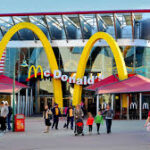Fatima Garcia entered a mosque in Doha to learn more about Islam while covering up with a black abaya, a long, loose-fitting robe.
The Salvadoran visitor, who was in Qatar for the World Cup with pals, took a day off from soccer to go sightseeing at the Katara mosque, where preachers have been teaching Islam to enquiring spectators from all over the world in a variety of languages.
As Garcia remarked inside the mosque, popularly referred to as the blue mosque due to its stunning turquoise tiles, “Qatar is my first introduction to Islam, exploring Qatar has been a life-changing experience since it opens your eyes to other cultures.”
Qatar has welcomed hundreds of thousands of visitors for the World Cup. Many people are making their first trip to a Muslim nation. Those who don’t leave the stadiums and the opulent hotels in Doha will only be exposed to a small portion of the local religion, such as hearing the call to prayer from afar or seeing Muslims kneel in prayer rooms in stadiums, airports, and hotels. But the Qatari government and religious leaders are eager to assist anyone who wants to learn more about Islam.
Visitors can take bilingual tours offered by neighborhood mosques, while the Islamic Cultural Center in Doha offers a virtual reality tour of Mecca. Free copies of the Quran are distributed at booths at tourist attractions, and hotel lobbies have displays of Islam-related literature. Ibtihaj Muhammad, a U.S. Olympic fencer, and other Muslim figures are featured on billboards placed all throughout Doha as part of a campaign to encourage people to learn more about Islam.
Why is it World Cup time? Everyone is traveling to Qatar, a Muslim nation, and there is a chance to spread knowledge about the religion, according to Abu Huraira, a volunteer for the campaign run by the Explore Islam Foundation and the Islam & Muslims Initiative.
Officials from Qatar express the hope that visitors will gain a better knowledge of both their culture and that of the wider region as a result of the competition.
Wahhabism, an extremely conservative branch of Sunni Islam, is practiced in Qatar. Contrary to neighboring Saudi Arabia, however, where adherence to Wahhabism led to strict segregation of unmarried men and women, the prohibition of women driving, and the decades-long ban on concerts, movies, and even yoga, Qatar has long supported the arts, permitted the participation of women in positions of high governance, and encouraged tourists to feel at ease.
However, the host nation of the World Cup has come under fire for failing to uphold basic human rights, including the rights of migrant workers, and for allegedly “sports washing” its image.
Officials from Qatar have claimed that their country’s advancements and accomplishments are not being recognized. Sheikh Tamim bin Hamad Al Thani, the head of state, claimed that “fabrications and double standards” were among the criticisms leveled at the first Arab and Muslim nation to host the World Cup.
Requests for response were not answered by the Supreme Committee for Delivery and Legacy of the host nation or the Ministry of Endowments and Islamic Affairs.
Riffat Ishfaq, a Pakistani tour guide, informed Garcia that Zeynep Fadillioglu, a Turkish interior designer whose first name is the Turkish equivalent of the name of the eldest daughter of the Prophet Muhammad, constructed the elaborate Katara mosque. Ishfaq claimed that the ceiling had gold on it, the columns were covered in leather, and the tiles had all been fashioned by hand. By the end of the journey, Garcia also understood the history of Islam and the justification for modest clothing for women.
“We want to introduce Islam to them. Ishfaq said, “We feel proud of our identity. Please preserve the abaya as a memento of our meeting. “This helps to clear up myths.”
Sergio Morales, a Guatemalan who had traveled nearby for the entire tournament, had just completed listening to a tour when he left the mosque and went to a booth near the door to request a free copy of the Quran.
Because the guided tour was in Spanish and he could comprehend it all, he said, “Today I became fascinated.” Every mosque ought to have guides in Spanish because so many people from Latin America visit these nations.
In the winding cobblestone lanes of Souq Waqif, the capital’s oldest market where shops peddle spices and perfumes, scented oils, and silk scarves, there are also booths offering free Qurans and books teaching the religion in numerous languages.
Only a few steps away, World Cup guests entered the spiral-shaped Abdullah Bin Zaid Al-Mahmoud Islamic Cultural Center for a tour and a visit to the mosque, where people gathered for Friday prayer.
The cultural center was visited by Carlos Bustos, Mireya Arias, and their boys, Matias, 13, and Jacobo, 8, respectively. A family from Colombia read the information on the enormous banners on the Islamic world’s contributions to science, arithmetic, and architecture.
“What we’ve observed is that they’ve made an effort to alter the perception of Islam that we have in the West. It’s dismantling that barrier,” declared Carlos Bustos, who was wearing traditional Qatari attire along with his sons.
They have said that we are very different, yet in his opinion, there are more similarities than differences.
His wife, Mireya Arias, praised Muslims for their steadfast adherence to their religion and for how they observed the call to prayer. She was grateful for Qatar’s attempts to introduce Islam to tourists.
They have employed a variety of techniques to get close to tourists so that we can comprehend and learn, she continued. “You can point to a QR code on the buses that carry you to the World Cup stadiums, and it will provide you with information about the Quran.”
The Museum of Islamic Art in Doha provides more insights into religious practices and rites. Visitors can read about the five pillars of Islam, including the hajj or pilgrimage, the confession of faith, prayer, almsgiving, fasting, and numerous Islamic burial customs.
A museum visitor from Brazil named Jose Antonio Tinoco, who was sporting his nation’s soccer jersey, stated, “The more you comprehend this Islamic culture, the more fascinating it is.” The section on Islam is, in my opinion, the most significant portion of the museum.

















